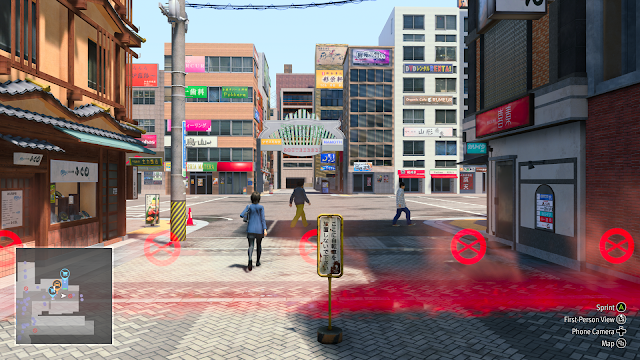The Forbidden Spaces of Like a Dragon
The doors are locked and they'll never open for me. On the street opposite the park, on the ground floor of a nondescript building in a covered shopping street, there's a clothes store where time stands still. One customer, an elderly gentleman, peruses sweaters. I stare through the shop window, but he's oblivious to my presence. In the other corner, a school boy waits patiently, perhaps for his mother to emerge from the changing rooms. He is static; bored rigid? And behind the counter there's a store clerk who will stand there all day and never interact with a paying customer. The easiest and loneliest job in the world.
I can look but I'll never set foot inside. No matter how many hours I spend in this town, and no matter how hard Joryu (formerly Kazuma Kiryu) learns to punch, we will never gain access. Off limits forever.
This is one of many forbidden spaces you'll come across when wandering the streets of Like a Dragon Gaiden: The Man Who Erased His Name, or any Yakuza game for that matter. They are everyday locations into which you can peer but not enter, where life goes on in a stunted, minimal, and strange way. A performance for our benefit, not theirs. They are barriers camouflaged as parts of the town, lining the inner and outer edges of Sotenbori and Kamurocho, confining us to the paths that the developer wants us to tread.
Of course, forbidden spaces exist outside of the Yakuza series, but they just don't leave the same impression as they do here. Nothing feels as lived-in as a Yakuza barrier, and I'm fascinated by their placement, content and function.
On the outer edges of a more traditional, outdoorsy sandbox, we would expect to encounter a mountain or a vast body of water to stop us in our tracks. A feature of overwhelming nothingness that brings our wandering to a sudden end. They line borders where we do not expect to see life, and certainly not hustle and bustle, and it's easy for us to accept that this is where we must turn back and return to the centre. In Yakuza's Kamurocho or Sotenbori, a main road can't lead to a dead end; you can't just erect a building in the middle of a busy street. There needs to be a way in and out of the town, even if it's closed to us, or a store that gives a building purpose. Functionally these spaces fence us in, but by allowing us to glimpse what happens beyond them, its makes Yakuza's linear spaces feel so much larger and vibrant.
One of the first things I do when I play a new Yakuza is sprint to the edge of the map and watch for a few minutes. I study the comings and goings, how pedestrians move between the world that I can touch and the one that I cannot, before they vanish. I think about all the other stories that are unraveling out there, beyond the red translucent fences. I can peer into the lives of others, but only until they turn the corner and my voyeur privileges are taken away. It's a strange feeling, disconcerting yet oddly comforting. Always fascinating.
Watching without being able to intervene, and losing our ability to affect the lives of others, is a theme that is explored to great effect at the end of Gaiden. I'll avoid direct spoilers here, but in those final moments we share in Joryu's emotions as he looks into his handler's iPad. We feel his sense of helplessness, but we're also reassured and comforted by the knowledge that life goes on without us.
Just beyond the barriers, out of reach but in view.




Comments
Post a Comment